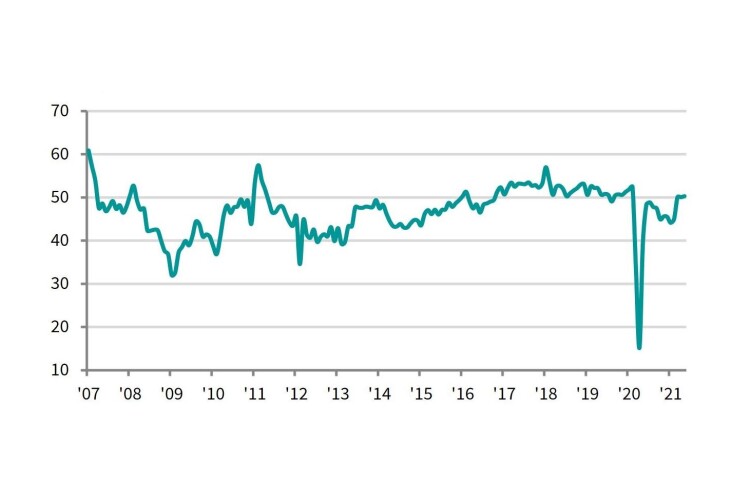There has been a record rise in input costs amid severe deterioration in supplier performance, according to the latest figures from the IHS Markit Eurozone Construction PMI. The research is compiled by IHS Markit from responses to questionnaires sent to purchasing managers in a panel of about 650 construction firms in the eurozone.
The headline figure is the Total Activity Index, which tracks changes in the total volume of construction activity compared with one month previously. The index rose slightly from 50.1 in April to 50.3 in May, signalling a third consecutive expansion in activity. Though fractional overall, the rate of growth was the quickest recorded since February 2020.
Usamah Bhatti, economist at IHS Markit, said: “The upturn in the eurozone construction sector continued in May, as businesses reported a slightly stronger expansion in activity. At the same time, new order growth resumed at a solid pace that was the strongest since February 2019. Yet, widespread reports of shortages of raw materials across the bloc and beyond placed severe pressure on supply chains, as indicated by a record lengthening in supplier delivery times. This contributed to the quickest upturn in input costs since data became available in January 2000. Nonetheless, construction firms in the bloc were increasingly optimistic regarding the outlook for activity over the coming 12 months. Confidence was positive for the fifth month running amid hopes that the end of the pandemic would boost activity and demand. At the national level, Italian and French firms reported rises in activity, with the latter recording the first expansion since June 2020. That said, German builders signalled a sustained and faster fall in construction output in May.”
Companies often linked the latest rise in activity to the start of new projects as demand resumed amid sustained government incentives for the construction sector.
Underlying data indicated that the upturn was centred on house-building. There was a softer fall in commercial construction and a quicker decline in infrastructure projects. May survey data pointed to a further expansion in home-building activity across the eurozone, stretching the current period of growth to three months. The rate of increase quickened from April and was the fastest recorded since February 2020.
Italian constructors led the upturn with the strongest expansion on record, while French firms noted the first rise in home building for 15 months. Meanwhile, German builders reported a further drop in activity, the fastest for three months.

Commercial building activity fell for the fifteenth consecutive month in May, although the rate of decline was the softest since this sequence began. A sharp decline in Germany was partially offset by a sustained increase in Italy and renewed growth at French commercial constructors.
Work undertaken on civil engineering projects decreased again in May. The fall stretched the current period of decline to 22 months. Notably, the pace of contraction was the quickest since February. Construction firms in France and Germany recorded marked declines in infrastructure activity, while a third consecutive rise was seen in Italy.
Confidence around the 12-month outlook strengthens by a steep increase at Italian companies, who noted the fastest expansion since January 2007. Moreover, firms in France registered growth for the first time in 11 months. German builders on the other hand indicated a further fall in construction activity, and one that was the quickest for three months.
New orders placed with eurozone construction companies returned to growth territory midway through the second quarter. Moreover, the rate of expansion was solid and the quickest since February 2019. Anecdotal evidence suggested that stronger demand and government incentives for the sector led to a rise in new order inflows. Across the three largest economies, Italian firms saw the sharpest increase since March 2001, followed by the quickest rise in France for just over three years. Conversely, new business in Germany fell for the fifteenth month in a row.
Vendor performance across the eurozone construction sector deteriorated at the sharpest pace on record in May. Average lead times lengthened rapidly in all three of the bloc's largest members, with German firms pointing to the most severe deterioration in the history of the survey. Firms overwhelmingly attributed delays to raw material shortages. Latest data showed an accelerated rise in input costs faced by eurozone construction firms. The rate of inflation was the steepest since aggregate data became available in January 2000, with a number of panel members citing higher raw material prices due to widespread shortages among suppliers. Underlying data indicated record rises in cost burdens at German and Italian firms, while the rise in France was the third-highest on record.
Got a story? Email news@theconstructionindex.co.uk



